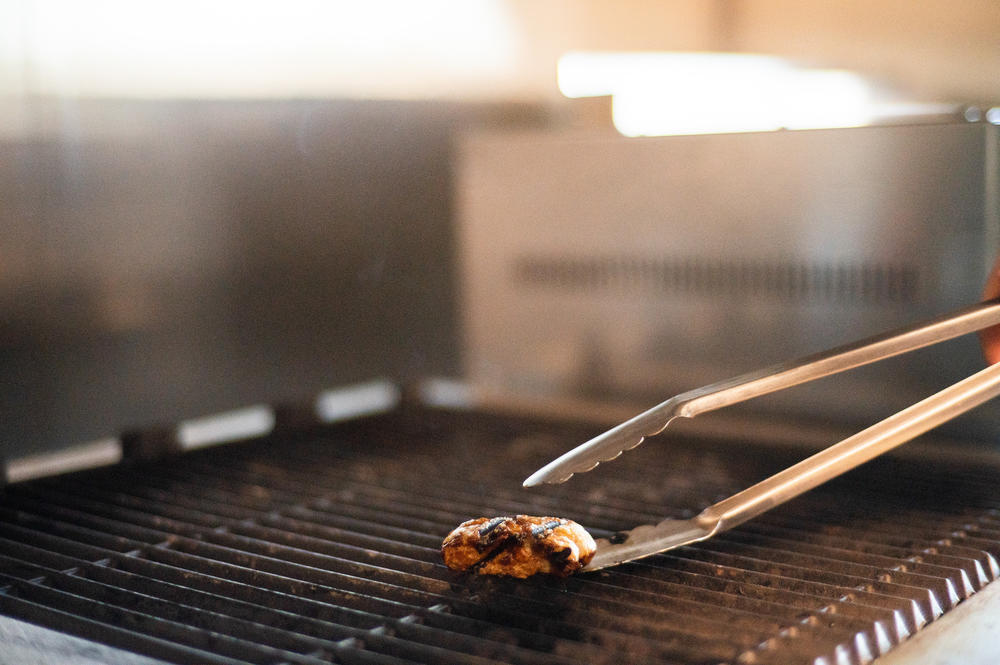Section Branding
Header Content
'No kill' meat, grown from animal cells, is now approved for sale in the U.S.
Primary Content
For all of human history, eating meat has meant slaughtering animals. But scientists behind cultivated meat say that's no longer necessary. They produce meat by growing cells extracted from an animal's body. And, today, the U.S. Department of Agriculture gave its first clearances to sell meat produced this way.
GOOD Meat, a division of Eat Just, Inc., announced that it has received approval from the USDA for its first poultry product, cultivated chicken, grown directly from animal cells, to be sold in the U.S.
"This announcement that we're now able to produce and sell cultivated meat in the United States is a major moment for our company, the industry and the food system, " said Josh Tetrick, co-founder and CEO of GOOD Meat and Eat Just.
GOOD Meat already sells its cultivated chicken in Singapore, which in 2020 became the first country to allow commercial sales of cultivated meat.
The USDA has also cleared the sale of UPSIDE Food's cultivated chicken. "This represents a historic step," Uma Valeti, CEO of UPSIDE Foods told NPR by text. The company also produces chicken grown directly from animal cells.
UPSIDE will debut with a textured chicken product, which tastes very similar to chicken breast and is made from over 99% chicken cells. I tasted it during a tour of the company's 70,000-square-foot production facility in Emeryville, Calif., where its meat is grown in large stainless steel tanks resembling a brewery.
I was served a piece of their chicken, pan-fried in a white-wine butter sauce. My first reaction: "It's delicious." (Isn't everything in wine-butter sauce?) And the texture was chewy, closely replicating the texture of chicken breast (minus bones, and tough bits or gristle.) "It tastes like chicken," I said, to which Valeti quickly replied, "It is chicken!"
At the outset, UPSIDE Food's facility can produce about 50,000 pounds of meat per year, with plans to expand beyond chicken, once this product is launched.
As NPR reported last fall, the U.S. Food and Drug Administration gave UPSIDE a greenlight, signaling its cultivated chicken is safe to eat. Last week, the U.S. Department of Agriculture approved UPSIDE's label, and today (Wednesday) the USDA issued a grant of inspection, which means the company has cleared the final regulatory hurdle and can begin sales.
"Today's historic announcement — two American companies earning regulatory approval to bring cultivated meat to U.S. consumers — marks a pivotal moment in food and agriculture," says Bruce Friedrich, president of the Good Food Institute, a non-profit that tracks investment trends in alternative proteins.
"Consumers are now one giant step closer to enjoying the meat they love without compromise," Friedrich says, pointing out that the goal is to give people the taste of meat without slaughtering animals and without the environmental footprint linked to traditional animal food production. More than 150 companies dedicated to producing cultivated meat and seafood have raised more than $2.8 billion dollars in investments.
"Everything we know about how meat can be made is going to change," Valeti says, who is a cardiologist, by training. "This is real," he told us. But don't expect to see cultivated meat in grocery stores just yet. UPSIDE's strategy is to build awareness about cultivated meat, promoting it as a way to build a more humane and sustainable food system. And the company knows its future depends on selling taste, too, which explains the partnership with a Michelin-starred chef.
Dominique Crenn, owner of the three-Michelin-starred restaurant Atelier Crenn, will serve UPSIDE's cultivated chicken at her restaurant Bar Crenn in San Francisco. And GOOD Meat has partnered with celebrity chef Jose Andres, who joined GOOD Meat's board of directors. Andres plans to serve GOOD Meat's cultivated chicken in one of his restaurants.
"We need to innovate, to adapt our food to a planet in crisis," Andres said when he partnered with GOOD Meat. The company markets its cultivated meat as "real" meat made "without tearing down a forest or taking a life."
Proponents say the cultivated meat is more sustainable and can be produced without antibiotics, and without producing methane emissions linked to animal agriculture, particularly beef cattle. And scientists warn that the typical way meat is produced now, in concentrated animal feeding operations, is a risk factor for the emergence of diseases.
About one third of human-induced greenhouse gas emissions come from producing food, and animal agriculture is responsible for much of it. Climate scientists have warned that to slow global warming, agriculture must change. Some scientists say it's uncertain whether cultivated meat can reduce greenhouse gas emissions – it will depend, in part, on the source of the electricity used to power its facilities.
Though many of the details are proprietary, the basic formula to produce cultivated meat is clear. It begins by extracting cells from animals using a needle biopsy. Food scientists no longer need to go back to the animal to extract cells every time, since there are lots of cells stored in a cell bank. The companies can select the cells they want to grow. Then, inside the stainless steel tanks, the cells are fed a mix of the same nutrients an animal would eat, a combination of fats, sugar, amino acids and vitamins, which allows the cells to proliferate and grow into meat.
UPSIDE says people who want to try their meat can check out their Instagram and Twitter accounts for a chance to join in on the first meal with Chef Crenn.
Copyright 2023 NPR. To see more, visit https://www.npr.org.


